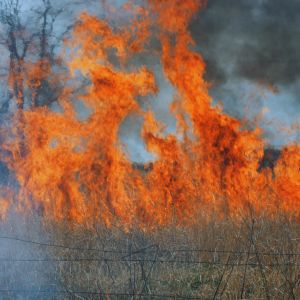Essential Steps for Creating a Fire-Resilient Property
 Even without a drought, wildfires are a growing concern across many regions, threatening lives, homes, and natural resources. Being “Firewise” means taking proactive steps to reduce wildfire risk around your home and property. This article provides high-level practical strategies to create a defensible landscape that helps protect your property from wildfire. A Firewise approach reduces the chance that landscape vegetation will carry fire to a structure. Creating a Firewise garden in Virginia means combining good design, appropriate plant selection, strategic placement of hardscape, and an ongoing maintenance plan.
Even without a drought, wildfires are a growing concern across many regions, threatening lives, homes, and natural resources. Being “Firewise” means taking proactive steps to reduce wildfire risk around your home and property. This article provides high-level practical strategies to create a defensible landscape that helps protect your property from wildfire. A Firewise approach reduces the chance that landscape vegetation will carry fire to a structure. Creating a Firewise garden in Virginia means combining good design, appropriate plant selection, strategic placement of hardscape, and an ongoing maintenance plan.
1. Core Principles
Begin by assessing your property’s location, vegetation, and surrounding environment. Map distances from structures, identify slope (fire moves faster and with greater intensity uphill), and predominant wind direction. Identify potential fire hazards such as dry grasses, overgrown shrubs, and flammable structures.
2. Create Defensible Space
Creating defensible space organizes the landscape into risk zones with distinct rules. Defensible space is the buffer between your home and wildland areas. It helps slow or stop the spread of wildfire and protects firefighters as they defend your home. Divide your landscape into zones:
- Zone 1 (0-5 feet from structures): Have nothing flammable next to the house, including trees, brush, tall grass, leaves, firewood piles, bark mulch, and other burnables. Keep this area lean, clean, and green. Remove dead plants, mulch, and debris. Use nonflammable landscaping materials and consider hardscaping such as gravel or pavers. Avoid plantings of pines, cedar, eucalyptus, and large patches of ornamental juniper directly adjacent to structures. Use low-growing herbaceous perennials and groundcovers.
- Zone 2 (5-30 feet): Maintain a well-kept lawn and avoid evergreens that catch fire easily and burn quickly. Space trees and shrubs apart to prevent fire from jumping between plants. Prune branches and remove ladder fuels—vegetation that allows fire to climb from the ground into trees. Favor deciduous plants in the near-home zones; their higher moisture content and seasonal leaf drop reduce flammability compared with many evergreens. Be cautious with ornamental grasses and evergreen shrubs: while attractive, many can ignite readily during dry periods.
- Zone 3 (30-100 feet): Remove yard debris and thin vegetation out to at least 30 ft. from the house. Thin out dense undergrowth and maintain healthy, well-irrigated plants. Remove dead trees and fallen branches.
3. Choose Fire-Resistant Plants
There are no fireproof plants! Select plants that are less likely to ignite, such as those with high moisture content, low resin, and minimal dead material. Trees and shrubs with the following characteristics are more desirable to have in a firewise landscape:
- Low overall height.
- Open, loose branching habit.
- Easy maintenance and low pruning requirements.
- Drought resistant
- Supple leaves that are mostly or have high water content
- Thick bark that does not peel away from the trunk
- Specific examples include:
- Moisture-retaining perennials and groundcovers: Hosta (Funkia), ferns (Polypodiopsida or Polypodiophyta), Sedum (Crassulaceae), creeping phlox (phlox subulate), yellow iceplant (Delosperma nubigenum)
- Deciduous shrubs and small trees: Dogwood (Cornaceae), Serviceberry (Amelanchier), hydrangea (macrophylla) ), Redbud (Cercis), Lilac (syringa species)
- Native flowering perennials: Coneflower (echinacea), Black-Eyed Susan (Rudbeckia), Salvia ( Lamiaceae), Lavender ( Lavandula), Virginia bluebells (Mertensia virginica), Heuchera (Saxifragaceae)
- See Virginia Firescape Resource material below for detailed information on plants and trees that are “fire-prone.”
4. Maintain Regularly
Routine maintenance is vital. Follow these tasks to keep your landscape firewise:
- Reduce continuous fuel by breaking plant layers horizontally and vertically.
- Keep flammable materials away from the building envelope.
- Select plants that retain moisture, have low volatile oils, and are low-growing near the house.
- Use noncombustible materials within the immediate perimeter of the home.
- Maintain irrigation and an active maintenance schedule to prevent dead fuel buildup.
- Remove dead plants, leaves, and pine needles from yards, roofs, and gutters.
- Trim trees and shrubs regularly.
- Keep lawns and groundcovers well-watered and mowed short.
- Dispose of yard waste properly—don’t burn it in high-risk seasons.
- Monthly in summer: remove dead flowers, rake leaves, clear debris from gutters and roofline.
- Quarterly: prune lower limbs, thin dense shrubs, remove dead wood, and inspect mulches near the foundation.
- Annually: evaluate tree crown spacing, chip or remove removed branches, refresh gravel or noncombustible surfacing within 0-5 feet as needed.
5. Incorporate Fire-Safe Landscaping Features
Using non-combustible materials in your landscaping creates firebreaks among vegetation, helping prevent the spread of flames. There are many options available for homeowners who want to include hardscaping features in their landscaping:
- Patios or walkways made of gravel, concrete, pavers, or natural stone.
- Stone seating areas.
- Outdoor kitchens.
- Gravel or rock pathways and ground cover.
- Retaining walls made with stone, concrete, or brick.
- Water features such as fountains, ponds, or pools integrate design features that reduce wildfire risk.
- Install metal fences instead of wooden ones near homes.
- Choose fire-resistant building materials for decks and outbuildings.
- Ensure that propane tanks and firewood piles are stored away from structures.
6. Prepare for Emergencies
Develop an evacuation plan for your household. Know multiple routes out of your area and keep emergency supplies on hand. Regularly review your insurance coverage and keep important documents in a fireproof safe.
7. Stay Informed and Connected
Stay updated on local fire conditions and weather alerts. Join community fire prevention programs and share Firewise practices with neighbors. Working together increases the effectiveness of wildfire preparedness.
Conclusion
Being Firewise in the landscape is about making informed choices and committing to ongoing maintenance. By applying these principles, you can reduce your property’s wildfire risk and help protect your community.
Additional Information Sources:
- Virginia Tech – Virginia Firescapes
- National Fire Protection Association – NFPA – Preparing homes for wildfire
- US Department of Agriculture – Make your home wildfire defensible | US Forest Service

